The mysteries of our heliocentric planetary system will always be a riddle to be solved. Our solar system still has so many deep secrets to be unfolded. As we all know, planet Jupiter is by far the most massive and largest planet in the solar system. In this article, we will try to uncover the Top 6 Interesting Facts About Jupiter.
I mean, the coolest facts about Jupiter like Why Jupiter Is Named Jupiter to the questions like How Many Moons And Rings Does Jupiter Have? So, just buckle up. We are going on a ride…!!!
How Did Jupiter Get Its Name?
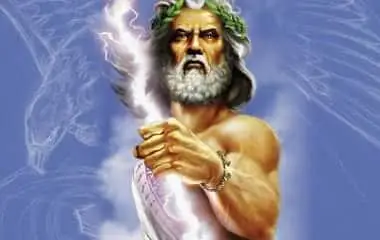
Well, frankly speaking; questions like who named Jupiter? Or, when was Jupiter named can never be answered with full certainty. On the contrary, questions like what was Jupiter named after? Or, most importantly; what god is Jupiter named after can be easily answered with full assurance.
Indian View
As I hail from India, so I will give the explanation from the Indian perspective on Why Is Jupiter Named Jupiter Or Brhaspati? According to the Indian sacred scriptures, Brhaspati was an Ancient Indian Sage of the Vedic Era.
Related, Great Scientists & Critical Thinkers Of Ancient India
He was popularly known as Deva Guru – meaning the guru or counselor of heavenly gods. Therefore, in order to honor or worship him, the largest planet in the solar system was named Brhaspati. So I can summarize that the (Brhaspati Graha) guru planet in English is called Jupiter.
Western View
Now let’s talk about the western perspective on Why Is Jupiter Named Jupiter? According to Roman mythology, Zeus was the king of gods as well as The God Of The Sky. For Greeks, Zeus was also known as Jupiter.
As it has been known for centuries that at night in a clear sky, Planet Jupiter can be seen with our naked eyes. Simply because Jupiter is the brightest and largest planet in the solar system. Therefore, roman astronomers named the largest and brightest planet after their most powerful god i.e Zeus Or Jupiter.
Related, Top 6 Fun Facts About Venus
Likewise, in different cultures; our largest planet Jupiter has a different name. According to German mythology, The Gas Giant was called “Thor” or like Asian-Turkish people call it “Erendiz”.
Similarly, for Chinese or Japanese astronomers, they used to call it “Wood Star”. This is how different cultures named our largest planet. As of now, Jupiter is the most commonly accepted name for the largest planet in the solar system.
How Many Rings Does Jupiter Have?
The next one in the list of Top 6 Fun facts about Jupiter planet is Rings Of Jupiter. Well, there was a time when people used to think that only Uranus and Saturn have a ring system. But in 1979, this view was drastically changed when the rings of Jupiter was first observed by the VOYAGER 1 – A Space Probe Launched By NASA.
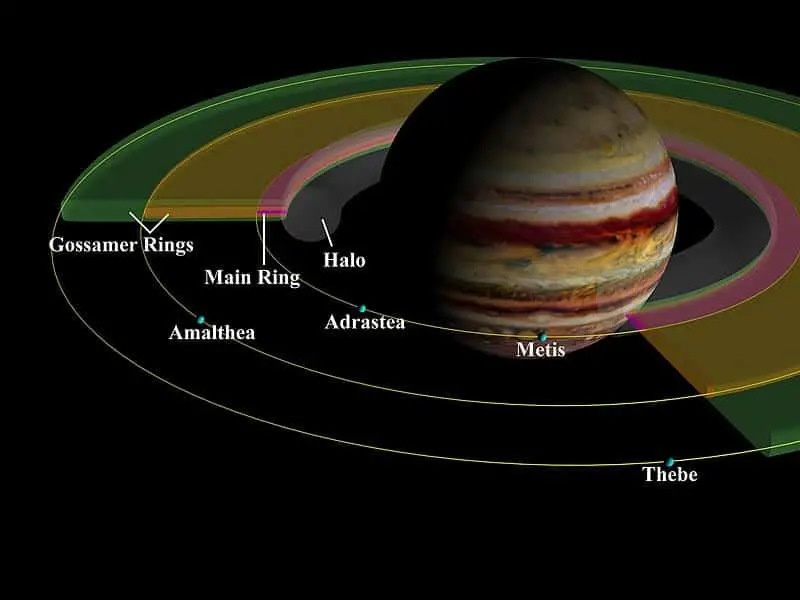
As per record, the Jupiter ring system has 4 Rings named – Halo Ring, Main Ring, Amalthea Gossamer Ring, and Thebe Gossamer Ring. These planetary rings around Jupiter’s planet are also known as Jovian Ring System.
Later in the 1990s, these Jupiter rings were thoroughly investigated by the Nasa’s Unmanned GALILEO orbiter. Well, if anyone wants to observe the rings of Jupiter from Earth, all they need is a powerful telescope with the largest aperture.
What Are Jupiter’s Rings Made Of?
As per the available data, these planetary rings of Jupiter are dull looking and mostly made up of dust particles. The Main Ring is relatively Brighter as well as very thin as compared to the rest of the three Rings Of Jupiter.
On the other hand, Halo Ring is quite thick and dusty. The other two rings (Amalthea Gossamer Ring, and Thebe Gossamer Ring) are named after moons of Jupiter i.e Amalthea and Thebe. Simply because the particle composition of these two Jovian Rings is made up of Amalthea and Thebe.
Which Planet Has The Shortest Day?
Any guess. Well, you are right…!!! The Gas Giant – Jupiter. The next one in the list of my Top 6 interesting facts about Jupiter is the Jupiter Rotation period. The largest gas giant has the shortest day out of all the planets of the solar system.
On the other hand, if you will ask me how long is a day on Jupiter? I would say that planet Jupiter is rotating on its axis on an average of 9 hours 55 minutes. Just to make sure that you don’t get confused; let’s say Jupiter length of day is about 10 hours.
Meaning, this gas giant is the fastest spinning planet of the solar system. In addition, if Jupiter compared to earth; well, of course, based on their spin. Planet Jupiter is spinning 28 times faster than the speed of rotation of the earth.
Also, the magnetic field of Jupiter is 20,000 stronger than the Earth’s magnetic field. Not to mention, due to the shortest rotation period and fastest spin of Jupiter, it has an oblate spheroid shape creating an equilateral bulge. Meaning, there is a difference between equilateral and polar diameter – creating an Oblate spheroid shape.
On the other hand, unlike planet Earth and Mars, there are no seasons on the surface of Jupiter. Simply, because the reasons for seasons for any planet is its axial tilt. And for this largest planet in the solar system, the Tilt of Jupiter is just 3.13° – which is quite less for having different seasons.
How Many Moons Does Jupiter Have?
The next one in the list of Top 6 cool facts about Jupiter is the ever-increasing moons of Jupiter. As per data released by International Astronomical Union on July 17, 2018; there are 79 known moons of Jupiter. On January 10, 1610, it was Italian Astronomer Galileo Galilei; the first astronomer to discover the Four Largest Moons Of Jupiter.
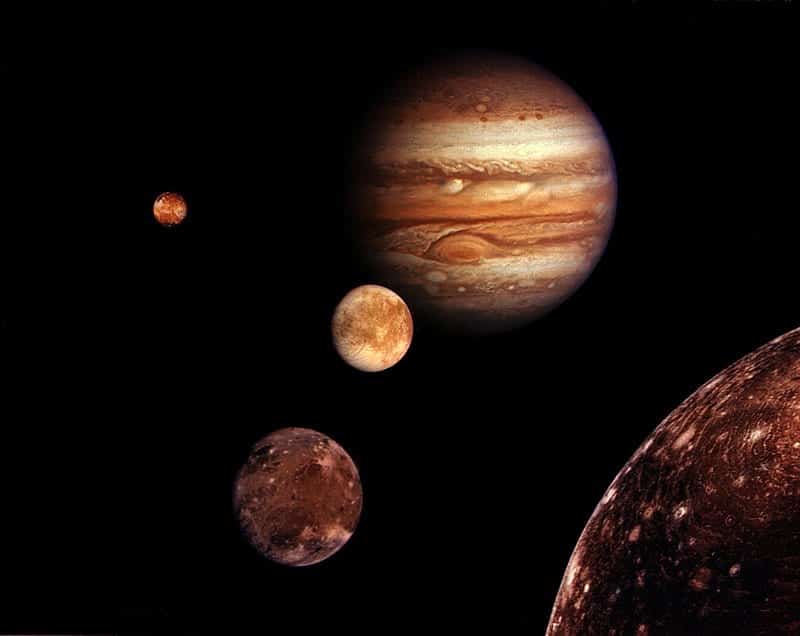
That is why these four natural satellites of Jupiter are known as Galilean Moons or Galilean Satellites Of Jupiter. These Galilean Moons are named as follows:- Ganymede Moon, Callisto Moon, Io Moon, and Europa Moon.
In fact, with the help of the discovery of these Galilean satellites, the 2nd century’s Aristotelian-Ptolemaic Universe (Geocentric Universe) was completely replaced by the Copernican model (Helio-Centric Universe) from the heart of all the physicists and scientific community.
Ganymede Moon Is the largest moon; not just for the group of Jovian moons. But by far it is the largest moon in the solar system. In fact, Ganymede Moon is the ninth largest object in the solar system; even larger than planet mercury itself.
Later from the dawn of the 19th century; with the help of high-tech telescopic photography and unmanned space probe, astronomers independently started to discover the small size moons (compared to the Galilean moons) taking the tally of Jupiter’s moon to 79.
Must read, That’s How Was The Moon Made
On 17 July 2018, the international astronomical union announced that American Astronomer Scott Sander Sheppard’s team have discovered 10 more small moons rotating around The Gas Giant.
Classification Of Moons Of Jupiter
In this article, we don’t have enough space left to name all the 79 Moons Of Jupiter. But still, on the basis of their structure and regularity, we can categorize all the 79 moons into two groups.
- The first group comprised 8 moons which are regular in size and almost orbiting in a circular path around planet Jupiter. These regular satellites of Jupiter are 4 Galilean satellites and 4 inner satellites (also known as Amalthea Group – Metis, Amalthea, Thebe, and Adrastea).
- The second group comprised of rest of the 71 moons of the Jovian system which are irregular in size and follow retrograde motion around the gas giant.
How Many Spacecrafts Have Visited Jupiter?
The next one in the list of Top 6 interesting facts about Jupiter is the history of space probes ever been to planet Jupiter. As per the data available till today, Jupiter’s planet has been visited 9 times by spacecraft. The name of the space probes is – PIONEER 10, PIONEER 11, VOYAGER 1, VOYAGE 2, GALILEO, ULYSSES, CASSINI-HUYGENS, NEW HORIZON, AND JUNO.
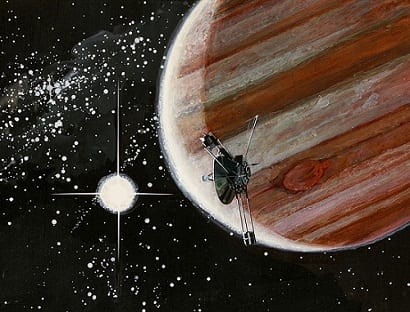
Pioneer 10 was the first spacecraft to ever visit the planet Jupiter. And by this mission of Pioneer 10 to Jupiter, it became one of the five artificial objects to ever achieve escape velocity to leave the solar system. After Pioneer 10, Nasa’s launched Pioneer 11, then Voyager 1 till the last one i.e Juno spacecraft.
Related, Top 6 Freakiest Facts About Space
Juno was launched by Nasa in 2011 and in 2016 it completed its orbital insertion maneuver successfully around Jupiter. Currently, it is still orbiting around Jupiter for its science exploration program related to The Gas Giant. Well, we all know now that Juno is the last spacecraft launched for the possible exploration of planet Jupiter.
And on the other hand, we also know that it won’t be the last one forever. As of today, the European space agency’s Jupiter icy moons explorer is scheduled to be launched in 2022 and Nasa’s Europa Clipper is also scheduled to be launched around 2025.
Mighty Jupiter’s Great Red Spot
Last but not least one in the list of top 6 fun facts about Jupiter is the Mighty Jupiter’s Great Red Spot. The Great Red Spot was first spotted by an Italian astronomer Giovanni Cassini in 1665.
All the information gathered by astronomers around the world suggests that this massive red spot located 22 degrees south of Jupiter’s equator is an anticyclonic storm that is being continuously observed by astronomers since 1830.
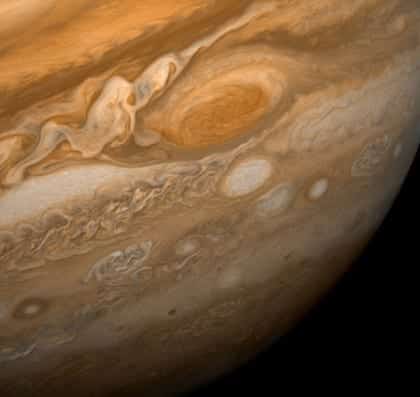
Some theoretical reports suggest that this anticyclonic storm existed for at least 300 to 350 years on the Jovian surface. The Great Red Spot is so massive in size that (say for a hypothesis) it could fit 3 or 4 earth size objects into itself.
Though due to the reduction in the speed of this anticyclonic storm, the size of the great spot is reducing day by day. Some astronomers calculated that by 2040 it could become circular in shape. Currently, the gas giant’s great red spot is kind of elliptical in shape.
Recommended, Top 6 Obsolete Cosmological models of the universe
On 25 February 1979, all the above theoretical theories were confirmed by Nasa’s Unmanned space probe Voyager 1 when it took up-close photographs of The Great Red Spot and sent it back to earth during its flyby of the planet Jupiter.
That’s it for this post. If you like this article, share it if you like it, like it if you share it. You can also find us on Mix, Twitter, Pinterest, and Facebook.
